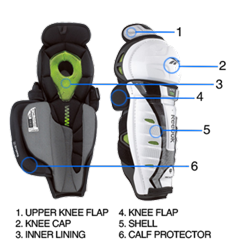Hockey 101
THE EQUIPMENT
Before we get started, it is important to keep in mind that safety and comfort are critical to ensuring players have fun and gain confidence while on the ice. That is why equipment must fit properly to assure maximum performance and protection. Age and experience will also be factors in determining the appropriate level of equipment.
Here is a preview of the most common pieces of equipment and their main purpose:

Moisture wicking undergarments – Provides warmth and protection from the gear itself while wicking away perspiration during play.
Supporter/Cup – Essential protective gear. Typically these include a one piece short with built-in cup and Velcro tabs at thighs to hold up ice hockey socks.
Shin Guards (right) - Should cover the knee and shin completely to protect from collisions, sticks and pucks.
Hockey socks – Part of the team uniform and should match the team colors; held in place with garter or Velcro tabs on jock short; pulled over and covers the shin guards.
Breezers/Hockey pants – Protection for lower spine/tailbone, hips and thighs. The length should come to the top of shin pads.
Skates – Skates are an essential piece of equipment to play ice hockey. Players and parents should place an emphasis on proper fit as skates that are too large (too much room for growth) will hamper skating abilities and comfort. Periodic quality sharpenings are essential for the skater’s success.

Shoulder pads – These are designed to protect the chest, shoulders and top of arms. Players should try these on to determine best comfort and size for mobility and protection.
Elbow pads (left) – Today's elbow pads are designed to protect the elbow from hard falls or collisions as well as protecting the forearms from sticks and pucks. To be effective, these should fit well enough that they do not move when worn.
Hockey jersey – Part of the uniform and may be provided by the team or purchased separately. Jerseys should be tried on with shoulder pads to determine appropriate fit. Generally, sleeves will come just below wrists to top of hand and length will cover to thighs.
Helmet with face mask – The head is the most important part of the body, and the helmet is designed to reduce chance of skull fractures. No helmet prevents concussions, but they can reduce the risk depending on padding and design. Construction and design must be approved by HECC which assures they have been tested and meet certain standards. The face mask minimizes facial injury from sticks or flying pucks.
Mouth guard – Essential for teeth protection.
Gloves - Protects hands, fingers and wrists. It is important to have good finger and hand mobility when worn.
Stick – A straight wood stick is a good starter stick for first time players. As players become more experienced, they can begin to make decisions on curve, lie and the use of composite sticks. Length of the stick should generally extend from the ice/floor to the player’s chin with skates on – an inch or two more of length is okay to allow for growth. Equipment experts can provide recommendations for each player and will cut the stick to the proper size.